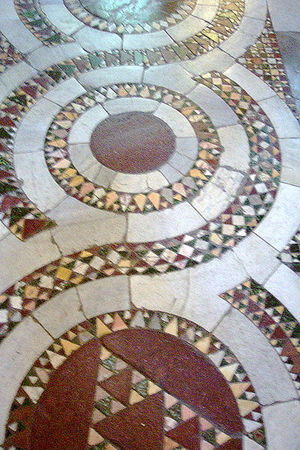Visiting the Basilica of San Clemente in Rome is like peeling back the layers of history. This church is as much a prime archaeological site as a place of worship. The 12th century church that appears today was actually constructed on top of a church from the 4th century, which was built atop a temple to the pagan god Mithras, dating back even earlier to the 2nd century BC. Today all three layers of worship are visible at this site. The site was also believed to have once been the home of Roman Consul Titus Flavius Clemens and a clandestine site for early Christians to worship.
While the remains of the pagan temple to the cult of Mithras are limited, the 4th century church is largely intact because it lay hidden for centuries until the 1860s when it was uncovered by the Dominican monks who still inhabit the monastery next to the Medieval basilica.
Entering San Clemente at the street level, visitors are usually struck by the stunning Medieval mosaics, which feature a cross on a gold background, surrounded by scenes of daily routine and swirling acanthus leaves. Marble choir screens from the church of the 4th century located in the main body of the church are decorated with early Christian symbols, such as fish and doves. Other elements worth exploring in the richly decorated church include the Castiglioni Chapel with frescoes by the Florentine painter Masolina da Panicale dating to the 1400s. He was a key figure in the incorporation of realism and the use of perspective in Renaissance artwork. Also worth seeking out is the charming cloister, where summer concerts are held.
From the nave on the right side of the San Clemente Basilica, stairs lead down to the 4th century ruins. Here visitors will find an extraordinary treasure, one of the largest collections of the earliest Medieval wall art, with both Latin and Italian inscriptions. This includes important frescoes depicting the life of St. Clement. This church was active until 1084, when it was irreparably damaged by the siege of Norman Robert Guiscard, which laid ruin to the church.
From the left nave, follow the signs to the Mythraeum. Here visitors will find the ruins of the ancient temple of Mithras, which was dedicated to the all-male cult that originated in ancient Persia (today Iran). Because legend has it that Mithras was born in a cave, he was worshipped underground. Remnants of a white altar with carved reliefs, including the image of a bull, still can be seen here.
Like much of Rome, throughout the centuries, such pagan temples were frequently covered with newer churches, or materials were used for other building projects (as with the bronze from the Pantheon used to construct the papal altar in St. Peter’s Basilica). That remains of this temple still exist is due in part to its secretive underground location.
Because this temple was once part of a home, there are adjacent rooms of the ancient house still on view, and excavation of the 4th century church also continues to reveal new treasures. San Clemente is truly an unusual example of the layers of Roman history still preserved. The age of the main church alone makes it a worthy stop on any visitor’s agenda. Adding to it, the ruins of the 4th century church and the 2nd century BC temple, makes this a very special place indeed.





